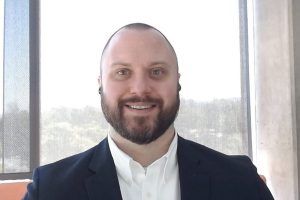
Tim Rupert ’07 (MSE) joined Johns Hopkins as a professor in the Department of Materials Science and Engineering and director of the Hopkins Extreme Materials Institute (HEMI) on July 1.
WHAT EXCITES YOU ABOUT RETURNING TO HOPKINS AND JOINING THE DEPARTMENT OF MATERIALS SCIENCE AND ENGINEERING?
Although I completed my undergraduate and master’s in mechanical engineering, I took a ton of classes in materials science and engineering. I was taught by Todd Hufnagel, Tim Weihs, and Jonah Erlebacher, just to name a few. It’s fun being on the other side of the classroom and teaching, and it feels like coming back home. I’m from Ohio, but the Homewood campus feels more like home than any other place I’ve been to.
A positive part of being an alum is the connections I’ve made with my peers. I always knew there was exciting research happening at Hopkins, and I’ve kept in mind that it’s a great place for students and professors. When the opportunity came to shift my career here, I was very excited to take advantage.
YOUR UNDERGRADUATE DEGREE WAS IN MECHANICAL ENGINEERING. HOW DID YOU END UP IN THE DEPARTMENT OF MATERIALS SCIENCE?
When I was studying mechanical engineering, my advisor Kevin Hemker showed me how MatSci and MechE can go hand–in–hand. I wanted to expand my skill set, so I studied for my PhD in materials science and engineering at MIT.
My lab group at UC Irvine challenged ourselves to push the boundaries of computational techniques, microstructural characterization, and microscopy techniques. We were eager to learn new things as we went—a quality I hope to bring to the classes I teach at Hopkins and our research.
This fall, I’ll be teaching mechanical behavior of materials, a core undergraduate class. It’s a natural fit for my interests and background; I study materials that make a new alloy or microstructure because we want to make materials with better mechanical properties. It’s fun because I like to connect real-world examples with some fundamental physics.
YOU’LL ALSO BE DIRECTING THE HOPKINS EXTREME MATERIALS INSTITUTE (HEMI). HOW DID YOU BECOME INVOLVED WITH EXTREME MATERIALS?
Much of my research is on nanostructured materials—high–strength materials that tend to have many grain boundaries and other types of defects in them. Naturally, I and others in this field push their limits and use them in “extreme environments.” An example is using nanostructured materials in nuclear reactors, with incredibly high temperatures and radiation fluxes. I’m excited to find out how we can push these materials further than ever before and enable new technologies.
CAN YOU SHARE SOME OF YOUR PLANS FOR HEMI AND HOW YOUR VISION ALIGNS WITH YOUR WORK IN MATERIALS SCIENCE?
With HEMI, I’m excited to expand the extreme materials we’re using and build from a solid foundation. I’m hoping we can grow activity in high-temperature materials, nuclear energy materials, and other extreme environments. We have a great group of faculty who are HEMI fellows, and I want to leverage their impact and grow the footprint of HEMI across the university.
I want HEMI to amplify and complement what the Department of Materials Science and Engineering is doing, too. Through engaging with faculty and the institute, HEMI can be a great resource for MatSci students and faculty.
ANYTHING ELSE STUDENTS SHOULD KNOW ABOUT YOU?
When I was at Hopkins, I played on the basketball team during my first two years. It would be so much fun to do a faculty and students basketball game sometime!